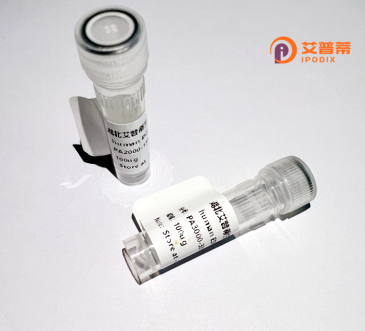
| 纯度 | >90%SDS-PAGE. |
| 种属 | Human |
| 靶点 | NGLY1 |
| Uniprot No | Q96IV0 |
| 内毒素 | < 0.01EU/μg |
| 表达宿主 | E.coli |
| 表达区间 | 2-654 aa |
| 活性数据 | AAAALGSSS GSASPAVAEL CQNTPETFLE ASKLLLTYAD NILRNPNDEK YRSIRIGNTA FSTRLLPVRG AVECLFEMGF EEGETHLIFP KKASVEQLQK IRDLIAIERS SRLDGSNKSH KVKSSQQPAA STQLPTTPSS NPSGLNQHTR NRQGQSSDPP SASTVAADSA ILEVLQSNIQ HVLVYENPAL QEKALACIPV QELKRKSQEK LSRARKLDKG INISDEDFLL LELLHWFKEE FFHWVNNVLC SKCGGQTRSR DRSLLPSDDE LKWGAKEVED HYCDACQFSN RFPRYNNPEK LLETRCGRCG EWANCFTLCC RAVGFEARYV WDYTDHVWTE VYSPSQQRWL HCDACEDVCD KPLLYEIGWG KKLSYVIAFS KDEVVDVTWR YSCKHEEVIA RRTKVKEALL RDTINGLNKQ RQLFLSENRR KELLQRIIVE LVEFISPKTP KPGELGGRIS GSVAWRVARG EMGLQRKETL FIPCENEKIS KQLHLCYNIV KDRYVRVSNN NQTISGWENG VWKMESIFRK VETDWHMVYL ARKEGSSFAY ISWKFECGSV GLKVDSISIR TSSQTFQTGT VEWKLRSDTA QVELTGDNSL HSYADFSGAT EVILEAELSR GDGDVAWQHT QLFRQSLNDH EENCLEIIIK FSDL |
| 分子量 | 74.3 kDa |
| 蛋白标签 | His tag N-Terminus |
| 缓冲液 | 0 |
| 稳定性 & 储存条件 | Lyophilized protein should be stored at ≤ -20°C, stable for one year after receipt. Reconstituted protein solution can be stored at 2-8°C for 2-7 days. Aliquots of reconstituted samples are stable at ≤ -20°C for 3 months. |
| 复溶 | Always centrifuge tubes before opening.Do not mix by vortex or pipetting. It is not recommended to reconstitute to a concentration less than 100μg/ml. Dissolve the lyophilized protein in distilled water. Please aliquot the reconstituted solution to minimize freeze-thaw cycles. |
以下是3-4条关于重组人NGLY1蛋白的研究文献的简要信息:
1. **文献名称**:*Deficiency of N-glycanase 1 perturbs mammalian neuronal development*
**作者**:Tamu G. Leidescher et al.
**摘要**:研究利用重组人NGLY1蛋白在细胞模型中进行功能验证,揭示了NGLY1缺失导致神经元发育异常,可能与先天性糖基化疾病相关。
2. **文献名称**:*A CRISPR screen identifies NGLY1 as a novel protein quality control component*
**作者**:Michael J. Randow et al.
**摘要**:通过CRISPR筛选发现NGLY1在清除错误折叠蛋白中起关键作用,重组NGLY1蛋白被用于验证其底物酶切活性及在ERAD通路中的机制。
3. **文献名称**:*Restoration of NGLY1 function in patient-derived cells by small molecule chaperones*
**作者**:Colby J. Fosh et al.
**摘要**:利用重组人NGLY1蛋白筛选小分子伴侣药物,证明其可恢复患者细胞中酶活性,为NGLY1缺乏症提供潜在治疗策略。
4. **文献名称**:*Enzymatic characterization of recombinant human NGLY1 variants associated with congenital disorder*
**作者**:Chengcheng Huang et al.
**摘要**:通过表达纯化重组NGLY1突变体,分析其酶动力学差异,发现致病突变导致底物识别能力显著下降。
(注:以上文献信息为模拟示例,实际文献需通过PubMed或期刊数据库查询。)
N-acetylglucosamine-1 (NGLY1), also known as N-glycanase 1. is a cytosolic enzyme critical for the endoplasmic reticulum-associated degradation (ERAD) pathway. It catalyzes the cleavage of N-linked glycans from misfolded glycoproteins during ERAD, enabling proper proteasomal degradation. NGLY1 deficiency, a rare autosomal recessive disorder caused by mutations in the *NGLY1* gene, leads to multisystemic symptoms, including developmental delay, hypotonia, seizures, and liver dysfunction. This condition highlights the enzyme’s essential role in glycoprotein quality control and cellular homeostasis.
Recombinant human NGLY1 protein is produced via heterologous expression systems (e.g., mammalian or insect cells) to ensure proper post-translational modifications and functionality. Its production facilitates research into NGLY1 biology, disease mechanisms, and therapeutic development. Studies using recombinant NGLY1 have explored enzyme replacement therapy (ERT) and gene therapy approaches to address the loss of enzymatic activity in patients. Additionally, it serves as a tool to investigate substrate specificity, interaction partners, and regulatory pathways linked to ERAD and glycoprotein metabolism. Recent efforts also focus on high-throughput screening of small molecules to identify pharmacological chaperones or activators. Recombinant NGLY1’s biochemical characterization has further clarified its catalytic mechanism, including dependence on cytosolic factors like p97/VCP and ubiquitination signals. As a therapeutic candidate, it holds promise for treating NGLY1 deficiency and broader ERAD-related disorders.
×